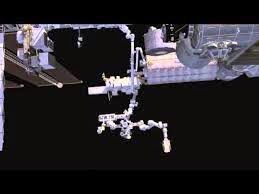Durante el pasado fin de semana, el robot espacial Dextre se convirtió en el primero capaz de repararse a sí mismo fuera de la Tierra, revelaron tripulantes de la Estación Espacial Internacional (EEI), lugar donde la máquina pudo repararse ella misma una de las cámaras de los brazos robóticos de la plataforma sin mayores problemas.
wn.com
Esta máquina, entregada por parte de Canadá a
la EEI en marzo de 2008, tiene como objetivo permitir la manipulación
desde la Tierra para la realización de ciertas tareas, una función
pensada especialmente para evitar paseos espaciales.
wn.com/view/2014
Para realizar estas tareas, el robot cuenta con una forma de torso sin cabeza con dos brazos largos de 3,35 metros.
Además, viene integrado con un sistema de enganches que
le permite moverse por la superficie de la Estación Espacial con la
ayuda de la máquina Canadarm, otro brazo dentro de la plataforma
espacial.
Fuente: wn.com/view/2014
Información:
Robot, heal thyself: Dextre becomes the first robot to repair itself in space
Dextre, the Canadian robotic handyman on board the International Space
Station, has done several repair and maintenance jobs to date, as well
as the Robotic Refueling Mission technology demonstration, when he
became the first robot to refuel a mock satellite in space. The space
bot is now poised to claim a first for robotkind: self-repair. This
animation shows how Dextre will swap two cameras on Canadarm2 and the
mobile base, which together form the three main components of Canada's
Mobile Servicing System.
Dextre will start by retrieving a faulty camera located near Canadarm2's elbow joint. Since the camera is functional, but produces hazy images, Dextre will move it to a less critical location on the mobile base. Dextre will then head over to Japan's Kibo module to fetch a camera from the module's transfer airlock —a type of sliding drawer that can be depressurized—where the station's crew will place it for Dextre to retrieve. Dextre will install the new camera on Canadarm2's elbow joint, where it will provide critical views of the robotic arm's movements.
In addition to repairing and replacing two valuable cameras used for robotic operations, Dextre's task has far-reaching implications for what robots could do in the future. Technologies for on-orbit robotic servicing—repairing and refueling satellites in space—hold great potential for addressing the issue of space debris, a growing concern for the world's space agencies. The work done by Dextre today is laying the foundation for the future when one day, robots will be sent to repair, refuel and reposition orbiting satellites. On-orbit robotic servicing could therefore save satellite operators from the significant costs of building and launching new replacement satellites, and help reduce space debris.
Find out more about...
Dextre's Robotic Refueling Mission:
http://www.asc-csa.gc.ca/eng/iss/rrm/
Saving satellites:
http://www.asc-csa.gc.ca/eng/iss/rrm/...
The Next-Generation Canadarm: A suite of robotic technologies designed to help explore space further and longer:
http://www.asc-csa.gc.ca/eng/canadarm...
Dextre will start by retrieving a faulty camera located near Canadarm2's elbow joint. Since the camera is functional, but produces hazy images, Dextre will move it to a less critical location on the mobile base. Dextre will then head over to Japan's Kibo module to fetch a camera from the module's transfer airlock —a type of sliding drawer that can be depressurized—where the station's crew will place it for Dextre to retrieve. Dextre will install the new camera on Canadarm2's elbow joint, where it will provide critical views of the robotic arm's movements.
In addition to repairing and replacing two valuable cameras used for robotic operations, Dextre's task has far-reaching implications for what robots could do in the future. Technologies for on-orbit robotic servicing—repairing and refueling satellites in space—hold great potential for addressing the issue of space debris, a growing concern for the world's space agencies. The work done by Dextre today is laying the foundation for the future when one day, robots will be sent to repair, refuel and reposition orbiting satellites. On-orbit robotic servicing could therefore save satellite operators from the significant costs of building and launching new replacement satellites, and help reduce space debris.
Find out more about...
Dextre's Robotic Refueling Mission:
http://www.asc-csa.gc.ca/eng/iss/rrm/
Saving satellites:
http://www.asc-csa.gc.ca/eng/iss/rrm/...
The Next-Generation Canadarm: A suite of robotic technologies designed to help explore space further and longer:
http://www.asc-csa.gc.ca/eng/canadarm...






No hay comentarios :
Publicar un comentario